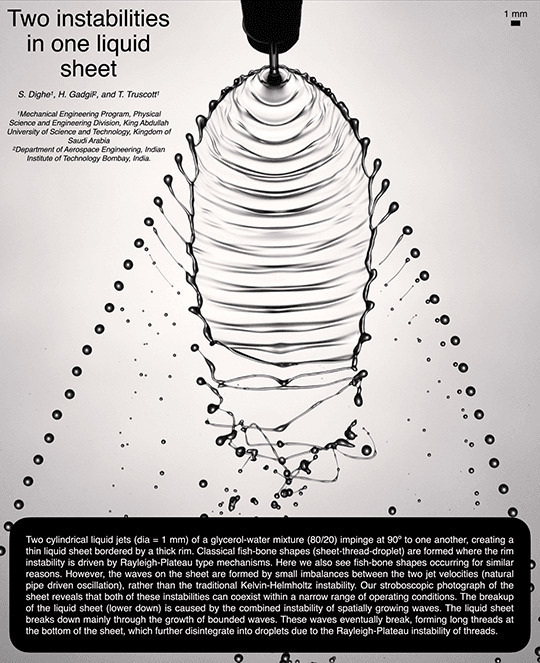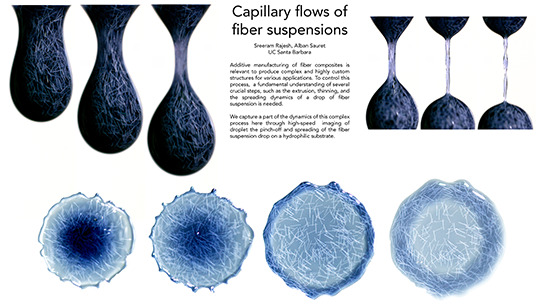#Plateau-Rayleigh instability
Explore tagged Tumblr posts
Text
Instabilities in Competition

When two liquid jets collide, they form a thin liquid sheet with a thicker rim. That rim breaks into threads and then droplets, forming a well-known fishbone pattern as the Plateau-Rayleigh instability breaks up the flow. (Image credit: S. Dighe et al.) Read the full article
#2024gofm#fishbone#fluid dynamics#fluids as art#instability#jet collision#physics#Plateau-Rayleigh instability#science
88 notes
·
View notes
Text
>> calculate models of Plateau Rayleigh instabilities
>> does not take surfactants into account
2 notes
·
View notes
Text
Radiation Transport Simulations of Pulsational Pair-Instability Supernovae. (arXiv:1904.12873v1 [astro-ph.HE])
Massive stars of helium cores of 35-65 Msun eventually encounter the electron/positron creation instability, and it triggers explosive carbon or oxygen burning that produces several thermonuclear eruptions. The resulting catastrophe collisions of eruptive shells sometimes produce luminous transients with peak luminosity of $10^{43} - 10^{44}$ erg/sec, known as pulsational pair-instability supernovae (PPISNe). Previous 2D simulations of colliding shells show the development of Rayleigh-Taylor (RT) instabilities and mixing. Here we present radiation hydrodynamic PPISNe simulations of a 110 Msun solar-metallicity star that was promising to produce a superluminous transit in the early work. Our comprehensive study contains a suite of one-, two-, and three-dimensional models. We discuss the impact of dimensionality and fluid instabilities on the resulting light curves. The results show the RT mixing found in previous multidimensional hydro studies transforms into a thin and distorted shell due to radiative cooling. Radiation from the wiggly shell peaks at its bolometric light curve of $\sim 2\times10^{43}$ erg/sec, lasting about 150 days and following with a plateau of $\sim 3\times10^{42}$ erg/sec for another two hundred days before it fades away. The total radiation energy emitted from colliding shells is $\sim 1.8 \times 10^{50}$ erg, which is $\sim 27\%$ of the kinetic energy of the major eruption. The dimensional effects also manifest on the physical properties, such as irregularity and thickness of the shell. Our study suggests PPISNe is a promising candidate of luminous SNe, the radiation of which originates from colliding shells with a homogeneous mixing of ejecta.
from astro-ph.HE updates on arXiv.org http://bit.ly/2V3kUUe
0 notes
Photo

Highspeed impact of small hydrophobic objects can generate several interesting physical phenomena (Rayleigh-Plateau instability leading to pinch of the air cavity, water curtain sealing which leads to Rayleight-Taylor instability). Here, the authors looked at the water entry of a dense millimetric sphere with a highspeed camera. The frames are separated by 1.9 ms. The 1mm radius sphere is coated to be hydrophobic and impact the water at 540cm/s. At the impact a splash forms at the surface and close inward sealing the air cavity which detaches from the surface and sinks with the spheres. The air being lighter than water, on top of the cavity there is water above (a bit like when you flip a glass of water). A Rayleigh-Taylor Instability arises and is clearly visible in a jet like form. In the mean time the cavity pinches off due to surface tension. The jet produced by the instability will then meet the end of the broken cavity and generate an under water splash. These events repeat with smaller bubbles. Reference: The water-entry cavity formed by low Bond number impacts,Jeffrey M. Aristoff, Tadd T. Truscott, Alexandra H. Techet and John W. M. Bush, Phys. of Fluids, 20 (2008) See also: Water entry of small hydrophobic spheres, Jeffrey M. Aristoff and John W. M. Bush, J. Fluid Mech., 619, (2009) #nakedfluiddynamics #fluiddynamics #fluidmechanics #physics #physique #splash #waterentry #waterimages #waterimpact #softmatter #scienceisart #science #artinscience #fluidartgallery #beautiful #picoftheday #awesome #mindblown #picoftheweek
#artinscience#waterentry#mindblown#softmatter#waterimpact#beautiful#fluidartgallery#fluiddynamics#awesome#picoftheweek#physique#nakedfluiddynamics#scienceisart#waterimages#fluidmechanics#science#physics#picoftheday#splash
0 notes
Text
"The Ballet of Colors"

Thomas Blanchard's short film "The Ballet of Colors" plunges viewers into a warm spectrum of roiling oil and paint. (Video and image credit: T. Blanchard et al.) Read the full article
74 notes
·
View notes
Text
Tweaking Coalescence

When a drop settles gently against a pool of the same liquid, it will coalesce. The process is not always a complete one, though; sometimes a smaller droplet breaks away and remains behind (to eventually do its own settling and coalescence). When this happens, it's known as partial coalescence. (Image and video credit: T. Dong and P. Angeli) Read the full article
#2022gofm#coalescence#coalescence cascade#fluid dynamics#instability#physics#Plateau-Rayleigh instability#science#surface tension#surfactant
51 notes
·
View notes
Text
Drops of Fiber Suspensions

To 3D print with fiber-infused liquids, we need to understand how these drops form, break-up, and splash. That's the subject of this research poster, which shows drops of a fiber suspension forming and pinching off along the top of the image. (Image credit: S. Rajesh and A. Sauret; via GoSM) Read the full article
#3D printing#droplets#fluid dynamics#granular material#hydrophilic#physics#pinch-off#Plateau-Rayleigh instability#science#suspension
54 notes
·
View notes
Text
The Sound of Bubbles

Every day I stand in front of my refrigerator and listen to the water dispenser pouring water into my glass. The skinny, fast-moving jet of water plunges into the pool, creating a flurry of bubbles. (Image credit: R. Piedra; research credit: M. Boudina et al.; via APS Physics) Read the full article
#acoustics#bubbles#entrainment#fluid dynamics#instability#jets#physics#Plateau-Rayleigh instability#science
50 notes
·
View notes
Link
27 notes
·
View notes
Text
Breaking Compound Ligaments

When pulled, viscous liquids stretch into ligaments that thin and then break into droplets. In this video, researchers investigate how these ligaments break up, depending on their composition. (Image and video credit: V. Thiévenaz and A. Sauret) Read the full article
#2021gofm#compound drops#droplets#fluid dynamics#instability#physics#Plateau-Rayleigh instability#science#surface tension
165 notes
·
View notes
Text
"Starlit"


In "Starlit" filmmaker Roman De Giuli explores a universe in a fish tank. The planets and asteroids we see are droplets of paint and ink floating in a transparent, gel-like medium. (Image and video credit: R. De Giuli) Read the full article
388 notes
·
View notes
Text
Paint Spinning

In a return to their roots, this Slow Mo Guys video features paint flowing on (and off!) a spinning disk. To help us see what's going on, Gav uses a trick that's familiar to many fluid dynamicists: he rotates the high-speed footage at the same speed that the disk rotates. (Image and video credit: The Slow Mo Guys) Read the full article
139 notes
·
View notes
Text
Animals Lapping

Without full cheeks, cats, dogs, and many other animals cannot use suction to drink. Instead, these animals press their tongue against a fluid and lift it rapidly to draw up a column of liquid. They then close their mouth on the liquid before it breaks up and falls down. (Image credits: top - C. van Oijen, others - S. Jung et al. 1, 2; research credit: S. Jung) Read the full article
158 notes
·
View notes
Text
Laser-Induced Jet Break-Up

A falling stream of water will naturally break up into droplets via the Plateau-Rayleigh instability. Those droplets are random, unless something like vibration of the nozzle sets their size. (Image and research credit: H. Liu et al.; via APS Physics; submitted by Kam-Yung Soh) Read the full article
#droplets#fluid dynamics#instability#jets#laser#optofluidics#physics#Plateau-Rayleigh instability#science#surface tension
75 notes
·
View notes
Text
Molten Thermite



This glowing, molten liquid captured by the Slow Mo Guys is thermite. The chemical reaction behind thermite is highly exothermic, hence its intense glow. There's some great fluid dynamics hiding in this video. (Video and image credit: The Slow Mo Guys) Read the full article
#chemistry#fluid dynamics#physics#Plateau-Rayleigh instability#science#supercavitation#thermite#vaporization
398 notes
·
View notes
Text
Slow Mo Espresso



High-speed photography gives us an alternate glimpse of reality. Here it provides an all-new perspective on making espresso. (Video and image credit: J. Hoffmann; submitted by Jerrod H.) Read the full article
242 notes
·
View notes